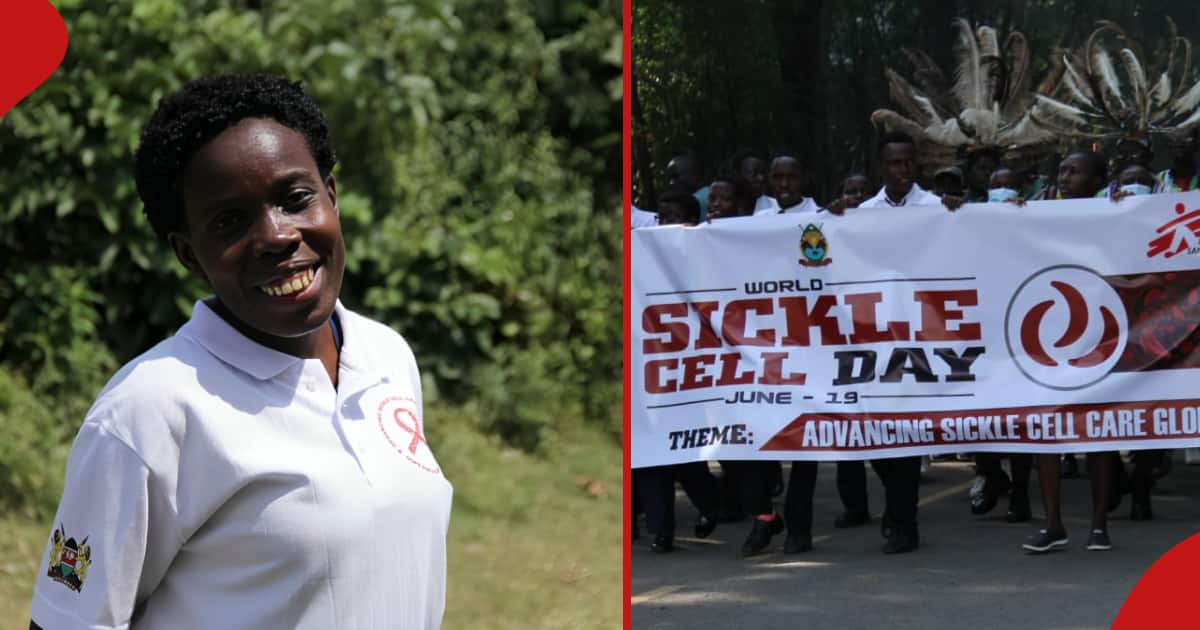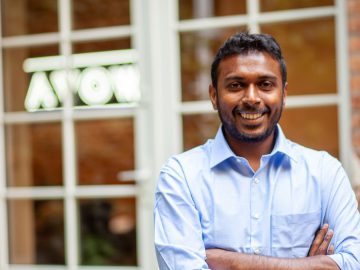- Molly Ochar, a sickle cell advocate in Homa Bay, says approximately 1400 babies are born with sickle cell disease each year in Kenya
- Susan Jabuto, a warrior against sickle cell anemia, and Helen Erick, a caregiver for sickle cell patients, have lamented the high cost of necessary prescriptions
- The two told TUKO.co.ke that they must cover the medical costs independently, citing neglect of the disease over time
Faith Chandianya, a journalist at TUKO.co.ke, brings over three years of experience covering politics and Current Affairs in Kenya
About 12% of Homa Bay’s 1.13 million residents suffer from sickle cell anemia according to county health acting director, Amos Dulo.
Sickle cell anemia warrior Susan Jabuto decried that the treatment of the disease is costly and needs a lot of financial resources. Photo: Florence Owiti
Source: Twitter
The disease causes blood deficiency, leading to weakness and reduction of one’s resistance to other illnesses such as malaria.

Read also
Nairobi Family Devastated as Man Dies 3 Months after Arrival to UK for Better Life
What are the challenges facing sickle cell patients?
Speaking to TUKO.co.ke, Amos Dulo said the number of sickle cell patients in the county has risen.
PAY ATTENTION: Do you have a video that never fails to make you smile? Spread the positivity by sharing it with us via WhatsApp: 0732482690.
Unfortunately, patients have had to pay for their medical expenses themselves, as the disease has been neglected over time.
“The National Hospital Insurance Fund has not adequately supported interventions geared towards sickle cell disease management that includes routine medical tests, special and the required medicines,” said Dulo.
What challenges do caregivers of sickle cell patients face?
Helen Erick, a mother of three from Suba North, has faced significant challenges in caring for her first and third born, who both have the disease.
Speaking at the World Sickle Cell Day celebrations on Wednesday, June 19, Erick recounted that when her first son was born in 2015, he exhibited strange symptoms and characteristics, but she did not initially understand what the problem was.

Read also
Kenyan Man Loses 6-Figure Job after Replying with “Sema” when Boss Called Him
“I was in and out of health facilities, and the nurses gave him antibiotics, which he used but got no recovery. At four years, that’s when he was diagnosed with sickle cell,” explained Erick.
She expressed regret for delaying her first son’s screening, noting that her third child, who was screened at birth and started treatment immediately, now appears healthier.
“Taking care of two sickle cell patients while you have a low income is horrific. Sometimes, I go to the hospital for treatment, and I’m told I can’t find medicine there, which forces me to purchase it from pharmacies around, which sell it at very high prices,” she decried.
She also mentioned that the medication must be taken daily to prevent attacks, with each tablet costing up to KSh 100, and a single patient needing two to three tablets per day.
Erick also highlighted the challenges in getting her husband to accept the situation, stating that initially, he did not understand, which led to domestic wrangles.

Read also
Los Angeles moves to ban smartphone use in school
“We had wrangles here and there, but I thank God he came to understand, and later confessed that some of his friends advised him to marry another wife who would give him healthy children,” she expounded.
Can sickle cell patients live a long life?
Susan Jabuto, a 31-year-old living with sickle cell disease, celebrated reaching her age despite misconceptions that individuals with the condition have shorter lifespans.
“The fear of knowing I may die any time hit me harder before the age of 15 before I got to understand my condition. Thereafter, I’ve been understanding how and when to take my prrescription” Jabuto explained.
She mentioned that while she knows how to manage her life, it’s a journey that demands substantial financial resources; without them, patients are vulnerable to experiencing sickle cell-related attacks.
The third born in a family of seven stated that she is the only one among five siblings with the disease.

Read also
Sween Moraa: Renowned KDF Lady Based at Kahawa Barracks Dies Days after Road Accident
With her understanding of sickle cell, she ensured her child was born free from the disease by advising her partner to undergo screening to determine if he carried the sickle cell trait.
Jabuto mentioned that the prescription they need are often in short supply, so they frequently have to purchase them themselves.
Many patients have very low incomes, making it extremely difficult for them.
“Another way the government can enhance good health provision to the patients is by providing more professionals who can help handle the patients,” she added.
According to Molly Ochar, a sickle cell advocate in Homa Bay, approximately 1,400 babies are born with sickle cell disease each year in Kenya, contributing to the increasing number of people affected by the condition.
Homa Bay mother lost 10 children to sickle cell anemia
In a separate incident, Jane Akinyi, 58, knows what loneliness and pain feel like, having been called a mother of graves, among other heartbreaking descriptions.

Read also
6 Family Members Including 3 Children Killed in House Fire, 5 More Injured
Akinyi’s 35 years in marriage are punctuated by the loss of 10 children and abandonment by the man she committed to share the rest of her life with.
She said that, together with her husband, they had 10 children and sadly lost all of them to a painful disease, sickle cell anaemia.
Proofreading by Asher Omondi, current affairs journalist and copy editor at TUKO.co.ke.
Source: TUKO.co.ke




